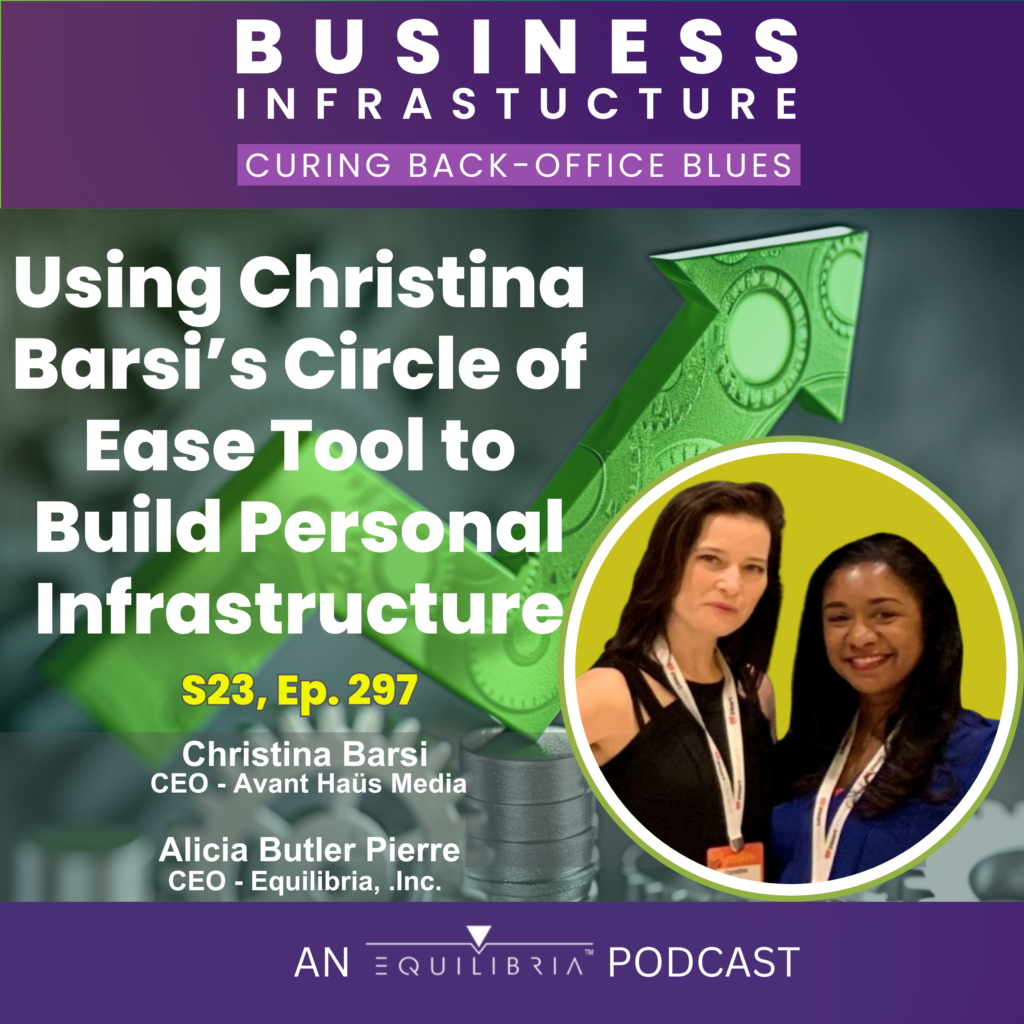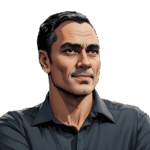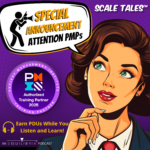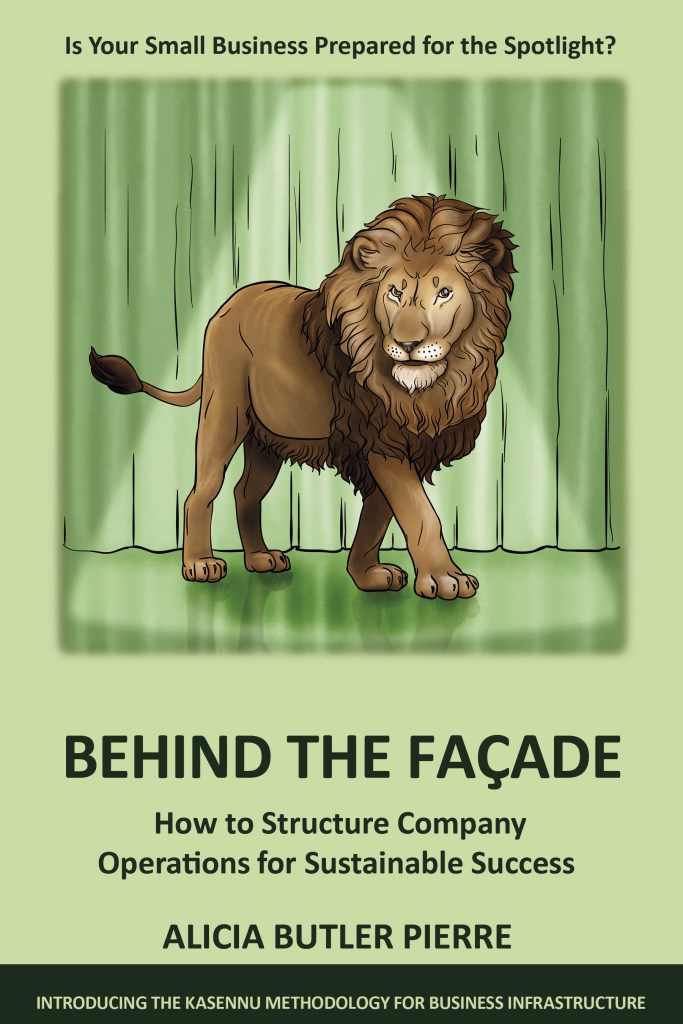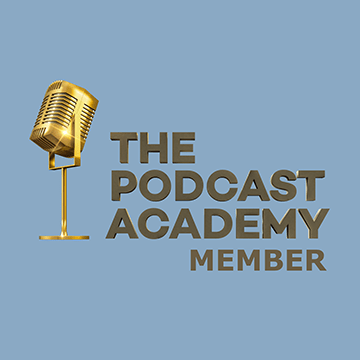Transcript
This is the Business Infrastructure Podcast, the show where we share operational tips, tactics, and strategies to help you cure any back-office blues you might be experiencing.

Welcome back to Season 23! If you’ve been following along this season, then you know that it’s dedicated to growth strategies. It’s structured as a masterclass featuring experts and tools to scale your operations, revenue, and profitability. As each subject matter expert is interviewed, I follow up with a monologue like the one you’re about to hear so that you have the benefit of knowing how to apply the information shared by each expert.
This episode features the second part of our interview with entrepreneur, Christina Barsi. It was so good, we had to split it into two conversations. So, as she describes her tool for building personal infrastructure, you’ll be able to follow along with me as I apply it to myself and my business growth goals. This is perhaps one of the most revelatory things I’ve done this year. Don’t be surprised if you also have a revelation you didn’t see coming.
This is Ep. 297: Using Christina Barsi’s Circle of Ease Tool to Build Personal Infrastructure
Okay, welcome back everyone. We ended part 1 of this interview with Christina Barsi, better known as simply “Barsi,” explaining what personal infrastructure is. There’s a tool she has called the Circle of Ease to build that personal infrastructure. As she explains this, I’m actually going to sketch it out so if you are able to view this interview on YouTube, you can check out what I’ve done there too.
Now that we’ve gotten that covered, Barsi, welcome back! For those of you who may not have listened to part 1 of this interview, can we start with you explaining what led you to creating a tool for building personal infrastructure?
I’ll try not to be as long winded as I tend to be, but I was very burnt out for various reasons, and I was trying to dig myself out of that hole, trying to find ways to bring myself back into alignment, ultimately into calibration, into a place that I know. I know how to feel good, and I wasn’t. I couldn’t figure out how to even get into the process of it again. So, I had to simplify it as much as possible. And that’s kind of where some of this strategy comes from.
The first thing I want to define is the difference between your zone of genius and your zone of excellence. Many of us, as entrepreneurs and doers, are really good at a lot of things. Your zone of genius. That’s the stuff that you have a wealth of energy for. It
doesn’t drain you. You could talk about it all day long and have just more energy from it. It’s regenerative, where the other stuff that you’re really good at, eventually it will tire you out. You won’t be able to do it forever.
It’s not an infinite well of energy, but you are great at it. So there’s a difference there. And I think we often get stuck in our zone of excellence, especially as entrepreneurs. Like, Well, I’m good at it. It does its job, and that’s it. But I don’t feel like it’s working, and I
don’t know why. It’s because you’re not operating enough in your zone of genius.

So, if I may recap quickly here…Barsi, it was your personal quest to find fulfilling work that led you to discovering this difference between your Zone of Genius and your Zone of Excellence. I know these are both critical areas of your Circle of Ease tool to help us build our personal infrastructure, right? Can you explain what the Circle of Ease looks like?
At the center of your circle of ease, it basically looks a lot like a brainstorm map with the bubble in the middle. And then you draw lines, and there’s bubbles on the outside, but we’re in the center. You have to do some pre-work with this. That pre-work is really
about getting clear on what your core desires really are. And the reason I say desires and not core values, because they’re values. You value these things, too, but they’re really the stuff that if no one was watching and no one judged you, this is how you would actually live your life.
Let’s say you had a child dream of being a singer or something like that, or whatever the thing is that your kid self wanted, or the dream that you put to bed because it wasn’t practical or whatever the reason. Oftentimes there’s some gold sitting there for us to
start to pay attention to and wonder about. And being curious is key here. It’s really wondering, I wonder what would happen? or What it would feel like if, fill in the blank? And those can be exploratory questions to start to understand what is really at the center of what you want to experience. And then you go through like a distillation process.
Okay, let’s go with the singer idea. Well, what is it about that that feels good? Is it because you get to inspire people with your music? Is it because you imagine yourself as a pop star and it sounds really fun and energetic and there’s movement involved? There’s more to it than, That sounds nice. Or, That seemed cool when I was five years old.
And if we start thinking about the things we want in this way. We start to see what’s missing. Oh, my gosh. I’m not having enough fun in my life! That’s a big category of something missing. Or, you know, I notice that everything that fills me up, that I have endless energy for is when I’m speaking from a place of inspiration. That one’s for me. Like, the conversation we’re having today, I could talk to you for hours. That’s why I’m so long winded about it. So I apologize for that. But it feels so good to me. So, you know, things that are inspiring.
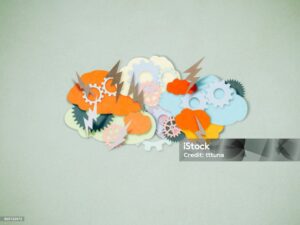
This is good! Okay, so at this point we have a sheet of physical or digital paper and we’ve drawn a brainstorm bubble or a cloud-like bubble in the center of that page. That’s where we write our core desires and it speaks to our Zone of Genius. So, I’ve drawn a bubble in the center of a digital piece of paper on my tablet. And inside, I’ve written “International Travel,” “Freedom from Daily Operations,” “CEO,” “International Business,” and “Teaching.” What’s next?
Then you draw little bubbles all around the big circle, like flower petals. There’s no lines just little bubbles around it and you decide what you want to map. So maybe it’s your business. Let’s go with that. I have a podcast agency, so the things I’m going to put in
the little pedals fall into my zone of excellence. These are the things that I’m really good at. I don’t have to think about really hard. They get done. They’re done really well, and they make me the expert that I am in the field that I’m in. They’re in my zone of excellence because they’re not necessarily inspiring me or I can’t do them forever.
They don’t feel like they are connected to that part unless I’m doing my own podcast, Be Bold, Begin. I loved creating that show. That goes inside my zone, my zone of genius, middle center bubble, because it brings ease into my life. That’s why it’s called the Circle of Ease. The rest I could delegate. I could delegate every single other thing I have to do for my business, and that would be fine. It doesn’t bring anything to me anymore. It doesn’t fill me up in any way, so…but I’m good at it.
So it goes in the pedals, the stuff that goes on the outside. So you draw lines, and then you draw another collection of bubbles on. On the outer, sort of circumference of all of this. And the things that go in there fall into stuff that. Maybe it’s hard for different reasons. Maybe it’s difficult because you’re learning something new, and that stage is just a little trickier and it takes time, but it’s understanding the difference between the stages, too.
Maybe another one is just difficult because you have to do it as part of the job, but you would like to get good at it enough to be able to delegate it. So, you want to move it into a pedal circle, but maybe you can’t yet because of whatever reason. Maybe you can’t afford to hire someone yet. Maybe you want to understand it better first so you can manage it better later. So this is a calibration alignment tool. You keep coming back to it. And what it shows you at first is how much percentage, how many bubbles is in the outside, how many bubbles are in the pedals, and then do you have any bubbles in the middle? Oftentimes you don’t, and you have to work towards that. So it gives you a lot of clarification. So then you can become intentional. This is where the strategy comes in.
Barsi, this is brilliant! It’s a visual way to understand how to move things about in your life – to either shift things that are hard toward an inner circle or petal while also figuring out what you can delegate. Here’s what I have in my diagram.

I’ve drawn another layer of bubbles surrounding the center bubble. I happened to draw six of them. Inside of those six bubbles are things like, “Podcast Production,” “Process Mapping,” “Project Management,” “……” These things represent my Zone of Excellence.
In other words, I’m really good at these things, but I don’t enjoy the administrative or maintenance portion of that work. I enjoy the original creation of that work. Hmm…I never thought about it that way until going through this exercise so this is interesting…
Next, I drew a third, outer layer of bubbles. And this represents the stuff that I’m learning, that I know is necessary for me to achieve more things in my zone of genius. I also need to go through the painful learning curve so that I can figure out what to start delegating as those activities move from the outer layer into the inner layers of bubbles.
In my third layer are the things I’ve had to learn as I transition my company’s business model from consulting to training.
Things like the painful process of drafting, reviewing, and negotiating legal contracts, acquiring a new business license for my commercial office, the accounting practices for managing a business with international operations…all of those things have all involved steep learning curves and has taken, at this point, half of 2024 to learn and develop processes around these things.
So, now that I have my Circle of Ease completed for my personal desires as it relates to my business, what comes next?
Then you can make a plan. All right, which one of these is the most painful, needs to change first? And you pick one, and then you create a small, approachable, kind, gentle action plan. And then the bubbles start to shift, and some go away because you handed them off to someone else who loves to do that thing that you don’t like to do anymore, and now you’re paying it forward as well because you’re putting it in someone else’s zone of genius instead of giving it to someone who also hates it.
We want to try not to do that. So there’s a way to kind of start making decisions in a really intentional way for you and for those that you bring on to help you. And it really paints a picture of where you’re at at any given moment with something, whether it’s a business, a creative project, an idea, something else, you can really use it in lots of different ways. And then you start making a plan for calibrating it in a way that feels more in tune with what you actually want to experience in your life and in your business. So you start to calibrate everything to align with who you really are.
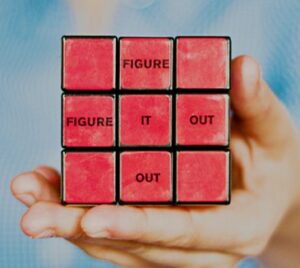
Got it! In looking at my Circle of Ease. I’d like to start looking at the Accounting bubble that’s in the outer layer. This is painful for a number of reasons starting with the fact that I had to fire the firm handling our taxes and bookkeeping a couple of months ago due to a huge mistake they made that cost us a lot of money.
Since I’ve fired them, I’ve learned more about the inner workings of how the Department of Labor, the IRS, and the Department of Revenue work. More than I ever thought I’d learn, and though it’s been painful, I appreciate it because now I know it for myself and I’m in an even better position to find a new accountant because I’ll know
what questions to ask.
I can even work with someone else on the team to setup our internal auditing records to check the work of this new accounting firm. To your point, Barsi, this will start to shift some of those things around as I am able to delegate more of those responsibilities. My work will then become more about management or oversight than getting deep into the details.
What are some other ways or techniques that you suggest for moving things around in a Circle of Ease?
So there’s a few ways to change the outer circles, if it’s something that you’re just learning, sometimes it just stops being hard because you’ve learned it, and then you decide, Does it go into the pedal circle where I get really good at it, but I keep doing it? Or maybe you delegate it right away because you’re able to, and you pop the bubble, it moves on, or it slides down into the zone of excellence, which is something you get really good at, but you have to keep doing it for whatever reason. Sometimes we can’t afford to delegate it yet, or it’s part of the process still.
Usually, you get really good at it, or you make a new assessment, like, Hey, I actually like this. Now that I’m great at it, I’m actually good with this. And you decide where it goes after that. Or you’re like, Well, I’m good at this. Now I know how it works. I don’t want to
do it. Maybe it’s something you need to figure out how to pass off. So, it could change multiple ways. Sometimes you need to change everything, and maybe none of it is really what you want anymore. And that’s eye opening and really difficult and is part of the process of change and pivots and getting what you actually want in life. And we have to look at it in order for that to occur.
Barsi, at what point do you recommend we revisit our Circle of Ease once we’ve created it?
The idea is that you work with it continuously, and the times that you take a break from the actual diagram itself is when you’re working the action plan that you’ve created to shift, then you come back and you redo it to see if things have shifted. And what usually
happens when we start creating some kind of change in our life is that it affects other things, too. So it might affect the way your whole diagram looks. You might end up with a whole different business.
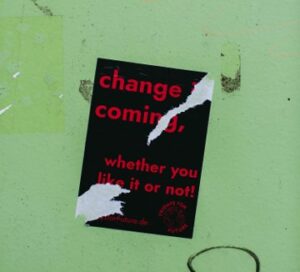
That’s exactly what happened to me! I have a vision for a completely new business model. And even though I shared that at the beginning of this Growth Strategies Masterclass, it wasn’t until I sketched this Circle of Ease that it became apparent why the old consulting business model no longer served me personally.
Because when you start, you know, getting into change more things, you open up other cans of worms, essentially. Usually it’s a little bit permeating. So really you want to spend a little bit of time on a very simple action plan. Let’s just try these couple of steps, see how that feels. There’s a whole process that I’m actually building a course where we use this tool and calibrate from the point of awareness all the way to aligned and embodied action planning so that you know how to use this tool consistently.
The goal is to decide intentionally what needs to shift and then creating small action plans to bring that into fruition and then reassessing. And the journey always gets confusing, which is why I think it really does need a full supported course and sort of
community around, you know, guidance around how to keep going with this.
I can see how this would have helped me level set or calibrate as you describe it after I did the Lean Canvas exercise at the beginning of this masterclass or maybe before.
Yeah, New Years are always great to kind of birthdays, right? That’s a personal new year to kind of be like, where am I at? What do I want next? When you’re feeling like something needs to change what needs to shift, that’s a good time to draw one out and see where you’re at.
And the Circle of Ease can help you make decisions too. Barsi, can you share more about the course that you mentioned?
Yes. So, basically, you’ll take a fun, short quiz to see if you’re operating in your zone of genius. You’ll get kind of like an idea of where you’re at sort of quickly, and then that unlocks the webinar for how to kind of walk through creating your own Circle of Ease. We’ll go into a little bit more depth than we did here, and that’s just a freebie. I’m not really selling you anything at the end of this webinar, so really it’s just a gift. But once you’re in my world, then, of course, you’ll get notifications of when the course is ready to jump on in on if that’s something you want to continue with.
It’s really great for people who are deciding what they want to do next. Oftentimes we’ve built something painfully, because it was our first business or, you know, whatever the thing is. And we’re like, I want to do this again, but it has to be different. It has to feel good this time. Or we want a personal brand because we’re like, Well, I have more to say, or I have a wealth of knowledge now that I want to share, or I’m inspired because of whatever the reason be. And this is a great way to start that conversation with yourself so that your action steps are aligned with what you really want this time.
Well, I must tell you Barsi this was an eye-opening exercise for me. One of the things that this Circle of Ease has also helped me become comfortable with is accepting my role as a Content Creator. I always rejected that title, but I really should fully embrace it. You know why?

Because I enjoy creating content, and I’m naturally good at it, and, most importantly, it feels good! Thanks for telling us more about your course and how our listeners can gain access to the Circle of Ease tool. Do you have other resources you’d like to share with us?
Oh, sure. I did an audio event recently. LinkedIn has an audio feature now. I did a talk recently with just an amazing speaker who has a wealth of knowledge in sound studies, and I have a podcast production agency, so I thought this would be a good topic for people who are service providers within the podcasting space because I launched a membership earlier this year for professionals within, particularly women professionals within the podcasting space called the Women’s Podcast Industry Network. And we’re just trying to create ways to connect.
Well, we’ll definitely have links to these resources in this episode’s show notes. Barsi, unfortunately our time together has come to an end. Thank you so, so much for this enlightening conversation! It was well worth the wait!
Oh, thank you so much! It was such a pleasure to be on, and it’s…it was just a joy. So thank you for having me and letting me talk about the things I love.
Hopefully you understand why I keep Barsi close to me. She’s a breath of fresh air and I always love listening to her perspective on things. As a reminder, you can watch our extended interview, both parts, on YouTube. There you’ll be able to see the Circle of Ease that I drew for myself. Keep in mind this is NOT the official template from Barsi. It’s important for me to not infringe on her intellectual property.
So, if you want the real Circle of Ease template, then I strongly suggest you reach out to her personally or via her website. You can access her contact information at BusinessInfrastructure.TV. Again that’s BusinessInfrastructure.TV.
Guess what? This concludes our Growth Strategies Masterclass, but I have one more revelation that the Circle of Ease gave me clarity on. I will talk about that after our end-of-season wrap-party episode.
Thank you for listening and please come back to the place where you’re listening so you don’t miss these next episodes! Until then, remember to stay focused and be encouraged. This entrepreneurial journey is a marathon and not a sprint.
This podcast episode was written and produced by me, Alicia Butler Pierre. Audio editing and sound design by Sabor! Music Enterprises. Video editing by Gladiola Films. A special thank you to the team here at Equilibria Inc., and to Grant Revilla for creating the show notes.
This is the Business Infrastructure – Curing Back-Office Blues podcast


